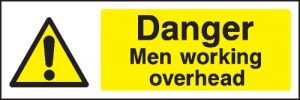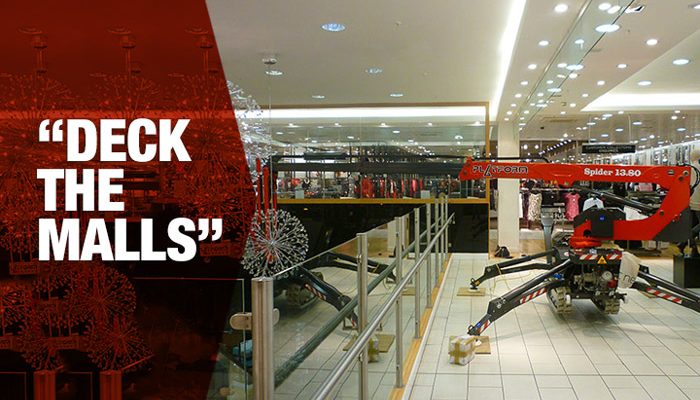
MEWPS Indoors – Deck the Malls
26 November 2017
MEWPS Indoors and the run-up to Christmas
It’s that time of year again! The festive season has arrived amidst a festoon of decorations hanging in all the shops. Wander through the malls and you can’t help but be impressed with the magnificence of the hanging decorations. Suspended as if by magic they are of course the result of careful planning and specialist working at height equipment. Operating MEWPS indoors poses a number of challenges for the teams involved.
General MEWPS Indoors
Operating MEWPS indoors can add to the usual safety concerns for the workforce. It can be complicated to get the MEWPS indoors to the work area, let alone set it up and start using it. MEWPS often need to be transported through a tight space and set up, taking care not to damage the surrounding environment and making sure the machine is fully operational and safe despite these additional limitations.
Our MEWPS Indoors
Our MEWPS have been specially designed to work indoors. They provide maximum functionality both indoors, and in tight spaces. Sometimes referred to as spider lifts, the name comes from the shape of the stabilizer legs. These legs fold up to enable the lift to be used in narrow spaces. They will pass through standard width doorways or gateways which would be problematic for other types of lift. This clever design does not mean a compromise on the overall functionality of the lift as they are still able to safely reach significant heights, and have strength and stability on the Mall floors.
Indoor MEWP Functions
They have a number of features which make them particularly useful for jobs indoors or in more delicate areas.
These include:
• A tracked chassis to spread the weight of the lift over a larger area and reduce the ground bearing pressure, preventing damage to fragile floors or pathways.
• Electric motor power option for indoor use which reduces operational noise with no exhaust fumes.
• Lower overall weight than other types of lift but with no reduced functionality.
• Easy to transport as most are road towable.
• Radio control options for use in tight space.
Due to their narrow design and low ground pressure make our MEWPS flexible and reliable on delicate surfaces. The spider-like legs can even be set up in different positions on different ground levels (for example steps or platforms). This means our MEWPS can be used in compact spaces where other lifts are unable to work.
Summary
MEWPS are the least disruptive type of powered access platform. They are not only flexible, but also adaptable for a range of unique and specific jobs. They have reduced noise, flexible access and can be used on most surfaces without compromising safety or functionality. MEWPS do not cause damage to more delicate surfaces, even in the most unusual spaces.
So the next time you are riding up the escalator admiring the decorations, spare a thought for the wonder of the MEWP that allowed it all to happen and tell the kids the Christmas fairies did it all 🙂
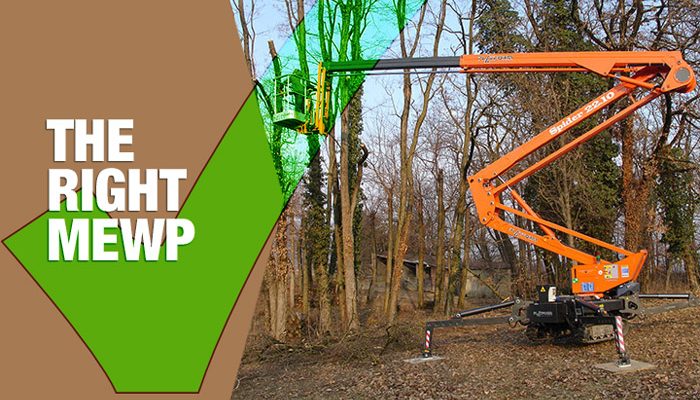
Choosing a MEWP For The Job
19 November 2017
Questions to ask.
Choosing a MEWP for a specific job can make a difference to the time it takes to do and how much it costs to get the job done.
Different models have alternative features that can suit very specific tasks at height and in a wide range of locations and circumstances. As with any job, it is essential to get the right equipment and the right people.
When you are choosing a MEWP there are some questions you need to ask to help you choose the right equipment for your specific business needs.
Location
• How far will people and equipment need to be transported?
• What is the height distance that needs to be reached?
• How many people will it take to complete the job?
• Is the job on or off site and how does this impact on the work?
• Are there multiple tasks that could require a vehicle mounted access platform?
Space and access
• Is the job indoors or outdoors?
• Is it a tight space that could require a spider lift?
• Is there sufficient room to reach the site, set up and safely install and remove the access equipment?
• Are there any obstructions such as branches or architectural overhangs which may need the flexibility of a boom lift?
Ground conditions
• Can the ground take the weight of the powered access platform?
• Are there any steep slopes or poor ground conditions?
• Are there any fragile surfaces that could require extra stability?
• Can the site be accessed by road or will it require an all-terrain powered access platform?
Frequency of use
• Do you have on-going jobs at height or is it a one off requirement?
• Is it more cost effective to buy rather than rent equipment?
• Do you have adequate storage space for an access platform?
Health and Safety
• Are staff trained to operate a powered access platform safely and effectively?
• Has a risk assessment been carried out on site?
• Does the job require heavy lifting?
Summary
Powered access equipment is a the safest option for working at height, especially if the job involves reaching awkward spaces, lifting heavy tools or equipment, accessing jobs in hard to reach areas or on unstable ground and fragile surfaces.
Different equipment can solve a range of specific problems including working indoors or in tight spaces (spider lifts); reaching jobs in remote areas (all-terrain vehicles); and carrying out multiple jobs on site in one go (mobile work platforms).
Each individual job and industry will have specific requirements for access equipment but asking the right questions are a good starting point to ensure you get the best powered access solution.
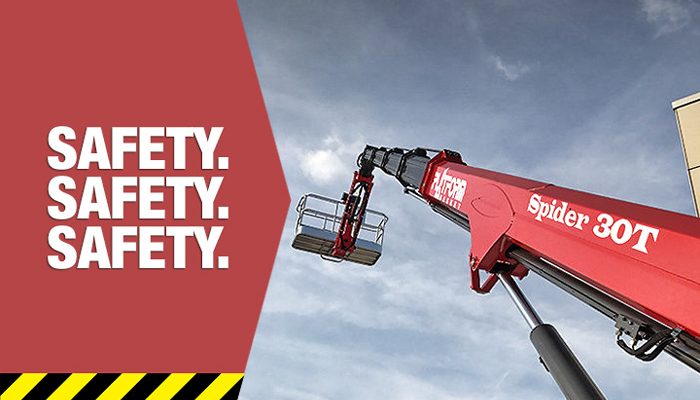
MEWPs – Safety at Height
12 November 2017
Every Day Before You Start
Think Safety At Height!
Thankfully accidents involving MEWPs have been declining over the last ten years. HSE legislation and IPAF awareness programmes have played an important role but on the front line it is the users of access power equipment who are pivotal in ensuring safety at height and reducing accidents.
For the safe performance of your powered access platform, is vital to ensure the equipment is in the optimum condition before every use. Maintaining and servicing access equipment will prolong its life and is required to meet health and safety regulations.
A pre-start inspection should be carried out every day and all staff should be briefed in what they entail. These checks will confirm that the machinery is safe to operate and identify any potential hazards it may pose before the work at height is carried out.
What to check
There are a number of key functions and features on access platforms which should be in full working order before the equipment is used. Even if the access equipment is rented from a reputable firm, the hirer is responsible for the health and safety of the people using it, so it is important to carry out your own checks as well as those done by the supplier.
Controls
– Test all lift controls before any people or equipment are raised from the ground. This should include cut out switches and emergency stop mechanisms.
Hydraulic fluid and petrol
– The oil level in the tank should be full when the platform is on a level surface and there should be enough fuel in the tank to complete the job.
Maintenance
– Check the vehicle for any signs of damage or age which might cause it to malfunction. This should include identifying damaged or loose hoses or fittings, rust, corrosion, holes and electrical faults.
Stability
– For a mobile access platform, the brakes of the vehicle should be fully functional. The base of a powered access platform needs to be locked into position before the platform is extended or elevated. Check all stabiliser legs and extendable parts are operational before use.
The Vital Safety At Height Risk Assessment
Before you set up a full risk assessment should be carried out at the site of any job to identify any potential hazards such as overhead power lines or underground services, and to check the ground conditions.
As a minimum you should…
• Make sure the ground is strong enough to take the weight of the equipment before you start to lift anyone or anything.
• Clearly mark off your work area to ensure you have a safe area to complete the job.
• Only allow trained operatives to control the access equipment.
• Make sure the powered access platform is fully stabilized before operation.
• Do not exceed the maximum load capacity of the access platform.
Summary
Carrying out the relevant checks before you start will ensure safety at height. It is worth checking the equipment thoroughly yourself as part of the overall risk assessment of your job. Not only will this ensure that your equipment is well maintained and fit for purpose for longer but it will also prevent avoidable accidents.
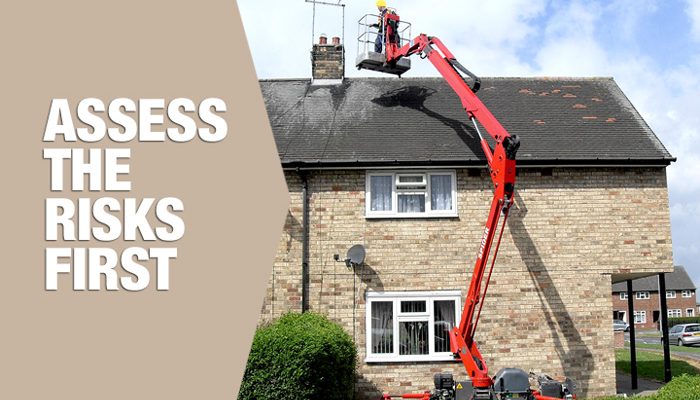
MEWP Risk Assessment
5 November 2017
MEWP Risk Assessment – Don’t start work without it!
Whether you are onsite or offsite, working at height requires a suitable MEWP Risk Assessment to avoid potential dangers.
In the construction industry, work at height is the main cause of fatal and serious injury in the construction industry. Worryingly, most accidents occur on smaller projects. Using powered access platforms does make carrying out jobs at height safer and faster but there are still potential risks and it is important to make sure all staff are aware of any precautions to take.
Health and Safety Executive (HSE) statistics show more than 60% of deaths resulting from work at height involve falls from ladders, scaffolds, working platforms and roof edges; or falling through fragile roofs. Although this has been a downward trend for the past 10 years, the financial cost has been significant along with the human cost to families and friends.
MEWP Risk Assessment – Accident prevention
To continue the downward trend of work at height accidents, the law requires employers and self-employed contractors to carry out an adequate MEWP risk assessment of the potential risks on each job so they can do everything ‘reasonably practicable’ to protect people from harm.
Carrying out a MEWP Risk Assessment does not need to be overly complicated but it does need to be an important part of planning and completing a job. Both the supervisors and the staff should be aware of the potential dangers so they can actively avoid them.
The HSE website provides full and detailed advice on planning and completing a risk assessment for a wide range of jobs but here are the five main points to consider:
The five Main Points
• Identify the Hazards – Walk round the site and make observations. Some of these may be obvious but it is worth getting a second opinion in case there is something you haven’t noticed.
• Decide who might be harmed and how – It may be a job onsite or there may be safety concerns for the general public. Make sure staff are adequately trained to complete the work and briefed on the requirements of the job.
• Evaluate the risks and decide on precautions – Avoid working at height where it is reasonably practicable to do so, for example can you get equipment or materials prepped at ground level?
• Record your findings and implement them – Check the maintenance of the powered access platform and other equipment and make sure that workers know how to operate it safely and effectively. Take extra steps to prevent any person falling a distance that could cause personal injury and use equipment to minimise the distance and consequences of a fall if necessary, such as safety nets.
• Review your assessment and update if necessary – circumstances change all the time so your assessment of the risks will too.
Summary
Powered access platforms make working at height safer and quicker but they do not remove all the potential risks such as dangerous structures, bad weather or accidents. A risk assessment will ensure that potential problems are managed and can be prevented, so each job is completed without an incident or injury. Visit the HSE website for more information.
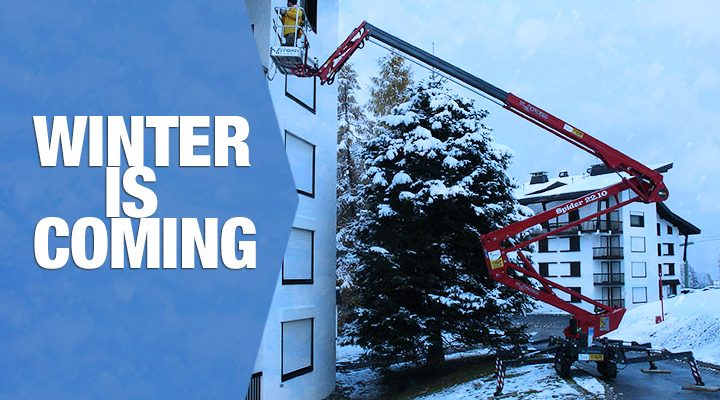
Working At Height In Winter
29 October 2017
Temperatures are dropping, overnight frosts are setting in and morning road ice is appearing.
Working at height in winter can mean working in harsh conditions with wind, ice and snow all added hazards for industries carrying out work at height. MEWPs (mobile elevated work platforms) are not only designed to be safe and fully functional in bad winter weather, but are used for essential maintenance tasks in towns and in the countryside to keep things running.
Working at height in winter can increase the health and safety risks for workers and create additional access problems. All-terrain powered access platforms are designed to minimise the risks and challenges posed by working at height in winter weather conditions. With their tracking spreading the weight of the equipment, it’s easier to reach hard to get to places, on and off road, in a safe and stable way.
Both tracked and four-wheel drive MEWPs are designed to reach higher in demanding work environments. They are lightweight and agile, with some four-wheel drives having different steering modes, and so are more mobile and easy to use on rough terrain. With an articulated riser and telescopic boom they make it possible to reach over obstacles, such as fallen trees or snow drifts, and sophisticated levelling mechanisms keep them stable and safe to use even when set up on severely sloping terrain.
Maintain Versatility When Working At Height In Winter
Even in the world’s most extreme weather conditions, powered access platforms are relied upon to get the job done. Specially adapted platforms for working at height in winter are available. Snow tracks, specialist oils and hostile environment kits have been used in Antarctica for construction on the compacted snow and ice of the Brunt Ice Shelf.
MEWPs are also essential for a number of jobs in icy conditions that keep our infrastructure and living environment safe and functional:
• Airports rely on powered access to de-ice planes before take-off which prevents additional flight delays. Ice can build up on the wings and structure of the plane creating a drag effect or even preventing take off. Powered access platforms are used to spray the plane with a de-icer that works at temperatures way below freezing, though high pressure hoses.
• Powered access is essential for making streets and built up areas safe in extreme weather conditions with essential maintenance such as removing icicles from the roofs of buildings which can be hazardous if they fall, clearing guttering and mending roofs that have been damaged by wind or icy conditions.
• Rescue situations and emergency services, including mountain rescue and the fire brigade, rely on powered access to manage situations quickly and safely even in bad weather.
Summary
These are just a few of the ways that powered access platforms are used to keep the country going in the harsh winter months. They are designed to cope with the harsh demands of winter weather conditions on and off road. With the ability to be stable and safe and access difficult areas, even in the face of obstacles, they are vital to safety in the working and living environments.
Please feel free get in touch if you would like more details. Alternatively our friendly staff are always on hand to answer any questions that you may have on 01226 716657.
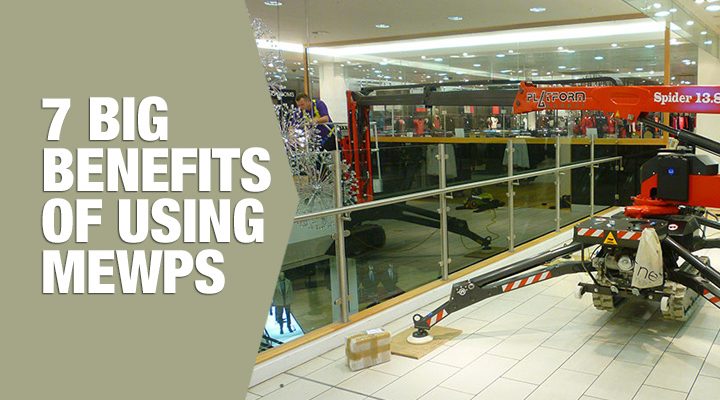
The Big 7 Benefits of using MEWPs
22 October 2017
The Big 7 Benefits Of Using MEWPS
• Flexible
• Fully mobile
• Access restricted space
• Use internally and externally
• Improve site safety
• Qualified Training available
• Cost effective
Key Benefits Of Using MEWPS
To get people, tools and equipment to heights safely and quickly, there are times when traditional working solutions can limit productivity.
Powered access platforms offer a flexible way to reach jobs at height – they are fully mobile and can access areas with restricted space, improve site safety, and save money. Different types of powered access platforms can support a range of industry sectors from cleaning windows, to construction sites, to saving lives.
Mobility Benefits Of Using MEWPS
Powered access platforms can be transported, set up and utilised quickly and easily with flexibility, depending on the demands of the job. Larger platforms can be road towed for set up on site, or vehicle mounted platforms offer maximum portability. Some models have the ability safely while the platform is raised; a major benefit for completing multiple jobs in different locations on or off site.
For tighter spaces or building interiors, spider lift access platforms are lightweight with low ground pressure. They can be used internally or externally without damaging floors or pathways and will fit through standard sized doorways and gates.
Even jobs in extreme conditions are accessible with all-terrain vehicles that have four wheel drive and four wheel steering options to access hard to reach places, and levelling controls that stabilise on steep sloped ground.
Safety Benefits Of Using MEWPS
Powered access platforms are a simple solution for lifting both people and essential equipment at height. Heavy tools or materials, specialist equipment or breakables are raised safely and quickly.
Industry standards regulate the manufacture and maintenance so they are easy to operate and robust.
Training in the use of access equipment is required by law but will benefit businesses in the long run as the equipment will be used quickly and efficiently by a small number of staff. Even road towable boom lifts have an on-board drive system. They are put in position by one person to reach heights of 10 to 26 metres.
Cost effective Benefits Of Using MEWPS
In most jobs, time is money and powered access platforms will save money by improving speed and efficiency. They are convenient and safe, reducing time spent on risk assessments and setting up equipment, such as scaffolding, onsite.
They require less staff to operate them, saving on labour costs, and are flexible and easy to move mid-job. They can also lift heavy weights and specialist equipment that might be costly to move around using traditional lifting methods.
Summary Benefits Of Using MEWPS
Whether you are looking to buy or hire the equipment, powered access platforms, are mobile, safe and flexible. They resolve a number of issues posed by traditional lifting methods. These include access to tight spaces, hard to reach areas, health and safety considerations and value for money. Whatever the size and location of your job, they are easy to operate and install, safe to use and can cater for a range of needs and requirements for different business that work at height.
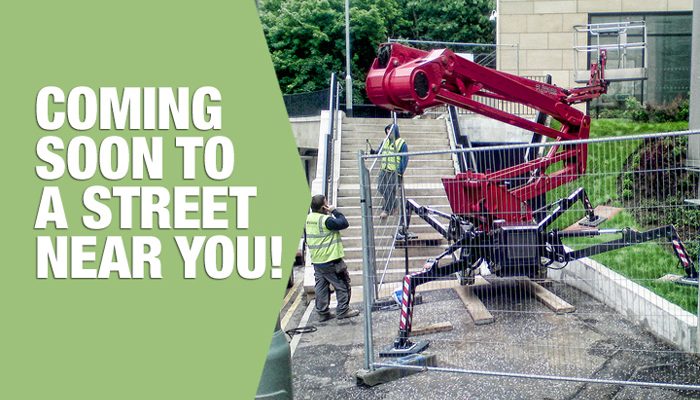
Urban MEWPs
15 October 2017
Improving urban areas with powered access platforms
Urban areas and town centres are always evolving and changing. They require on-going maintenance by contractors and local authorities which is often aided by powered access platforms.
Many of these jobs are at height and need to be carried out in the fastest and safest way possible to avoid disruption for people and businesses, and minimise the risk to operatives and pedestrians in built up areas.
Urban areas pose a number challenges for jobs at height:
• Pedestrians who may be moving in and around the working area
• Weather which is changeable and could be affected by nearby buildings
• Unstable ground conditions on pavements or pathways. Shallow sewers and services underneath will restrict weight loads and may require a tracked access platform
• Multi location jobs means there may be a need to move between tasks quickly using mobile access platforms
• Obstructions from buildings, street lights, trees and overhead power lines could all pose a problem when attempting to reach a job at height
Jobs for urban MEWPs
Access equipment is a common sight in town centres and streets as it used by numerous industries for a range of essential tasks including:
• Construction – building sites use access platforms for jobs including roofing, tiling, windows and services.
• Maintenance – Powered access platforms are used to carry out repairs and servicing to street lighting, clearing gutters, fixing roofs, window cleaning and to complete other general repairs.
• Signage – Signs are essential to urban areas on highways and streets and for private companies such as retailer and businesses
• Rescue situations – The fire service depends on powered access platforms to help them save lives. This could be reaching high windows to get people out of a burning building or even a lift with a hose to target water at specific areas of fire. Many of the platforms can carry heavy weights and multiple people and reach significant heights quickly and safely.
• Tree surgery and landscaping – Trees need to be kept under control to avoid the dangers of falling branches or poor visibility for vehicles and a powered access platform is not only quicker but much safer and less exhausting than climbing a ladder to reach the top of a tree and then use a chainsaw. They are also used to clear steep verges and embankments of vegetation and debris.
In Summary
Powered access platforms keep town centres and urban areas running efficiently and safely. They are essential for both new buildings and development and for taking care of the existing properties and infrastructure. Flexibility in terms of access and mobility, bearing weight and avoiding obstacles, means most jobs at height in urban areas can be completed safely and quickly without causing a major disruption or putting lives at risk unnecessarily.
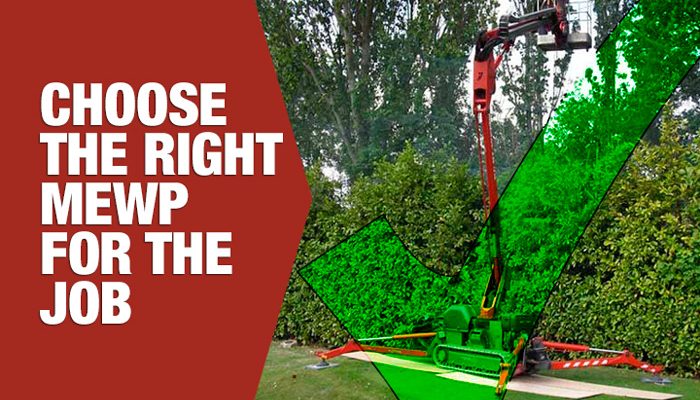
Finding A MEWP For The Job
8 October 2017
Selecting equipment for work at height
Powered access platforms offer a safe and speedy solution to reach most jobs at height but with a wide variety of machinery specifications, it is important to be mindful of a few things whilst finding a MEWP for the job.
Different types of access equipment have been specially designed for jobs in certain environments, for example, spider lifts can be used on fragile floors and in confined spaces whilst road/rail access platforms have a dual functionality to run on the road and train tracks. Getting it wrong can not only slow a job down, costing time and money, but could increase the health and safety risks to the workforce and public as well.
What to consider at the MEWP site
A site visit to the job location is essential to determine which high access equipment to use.
Consider the following things:
• Are there any steep slopes?
• What are the ground conditions like?
• Are there obstructions such as steelwork, overhangs or power lines?
• Look for fragile surfaces such as tiled floors or pathways
• What space is there to load at floor level?
• How high up is the job?
• Are there height and width restrictions?
Other considerations whilst finding a MEWP:
Mobility
Access platforms are flexible and can lift people and equipment to the necessary height in less time that it takes to climb a ladder or scaffold and winch up the necessary tools. Mobile access equipment which is mounted on a vehicle or truck is ideal for multiple jobs in one location.
Access
Often powered access platforms can access jobs which are hard to reach or dangerous with traditional scaffolding or ladders. Boom lifts have a telescopic reach which can avoid obstacles such as architecture or overhanging branches. Spider lifts are designed for use in confined spaces, including jobs indoors, and can pass through a standard sized doorway.
Safety
Consider the potential for falls and whether you need any additional safety equipment such as guardrails, nets or safety harnesses. Make sure the people operating the access equipment are fully trained to do so.
If you are still unsure about the best powered access platform to use for your job then ask for advice at the place where you plan to rent or buy from.
Summary
Whatever machine you select, it is important to familiarise yourself with the specific make and model. Choosing the right access equipment will make a big difference to the speed and safety of your job.
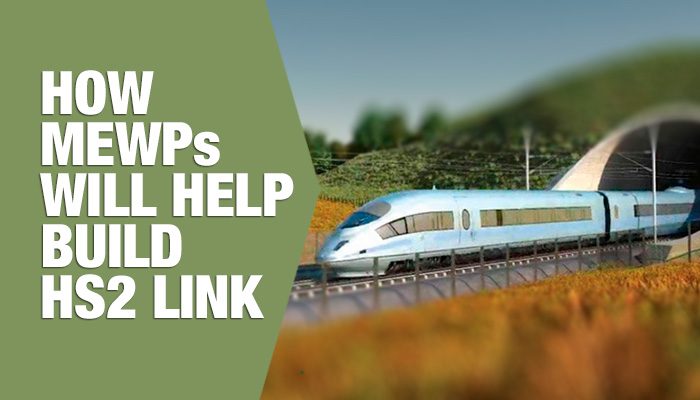
Construction Of The HS2 Rail Project
24 September 2017
How Road Rail MEWPs Will Help Construction Of The HS2 Rail Project
After being given Royal Assent, work has begun on the government’s HS2 rail project across the UK and powered access platforms will be pivotal in both the construction and maintenance of the new line. Contracts worth £6.6 billion have already been placed for the building of the first phase.
The first phase of the government’s HS2 rail project will be from London to Birmingham and operational trains are expected by 2026. Phases 2a and 2b will follow with services from the West Midlands to Crewe due in 2017 and then from Crewe to Manchester by 2033.
Road Rail access platforms are being used for essential jobs at height on the national railways. Jobs which are especially relevant are:
• Repairing and installing signals and posts
• Structural inspections of bridges, viaducts, stations and embankments
• Clearing verges and embankments of vegetation and debris
• Work on power lines
Jobs that overrun on the railways can be expensive. They have a knock on effect on services and commuters so safe, rapid access to the track is vital. Road rail access platforms are specially adapted to run on the road in addition to the rail infrastructure. This provides a flexible solution so jobs can be reached and completed quickly, and also safely, with minimal impact on the surrounding environment.
Having the ability to operate on road and rail tracks does not reduce the speed or functionality of the equipment. It is easy to switch from one operation mode to the other and it saves money as well as time. This is achieved by reducing the need to hire locomotive plant or attempt access through protected or remote areas of countryside.
The Robust and Efficient EVO/2-400
Newer models are more not only robust but also more efficient than ever before. First supplied to the UK in 2003, the current Basket RR14 EVO/2-400 road rail access platforms supplied by Promax Access are third and fourth rail compliant with more than 30 improved features including
– a 400kg capacity cage;
– easy to use and intuitive control system;
– Unique automatic self-levelling turret -200 cant;
– RIS 1530 issue 5 compliant;
– heavy duty rail gears with automatic disc brakes on all of the rail wheels;
– four wheel drive.
Many locations along the route of the new HS2 high speed rail track are hard to reach. There are limits to the usefulness of trucks and tractors for a number of essential construction and maintenance jobs. A road rail powered access platform is a flexible, cost effective and safe solution that will enable crews to access difficult places and carry out challenging jobs, quickly and safely.
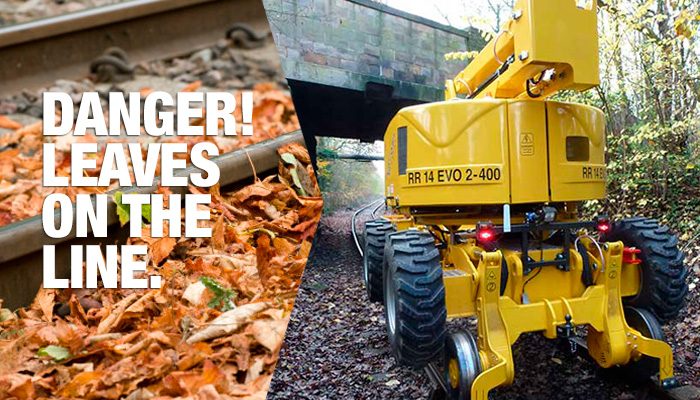
Promax – Minimising Delays With Access Platforms For Railways
17 September 2017
Access Platforms For Railways And Railway Maintenance
It’s the time of year when high winds blow leaves and fallen debris around. This causes serious problems in terms of safety and delays for commuters. Keeping vegetation under control is an essential job on the UK’s rail network and access platforms for railways play a vital role throughout summer and autumn.
Fallen leaves, overgrown grass verges, and overhanging branches are a hazard on the railways. They cause signal and track obstructions which will delay services, inconvenience commuters and pose a risk to health and safety.
Many miles of UK rail lines are in hard to reach rural areas. road and rail access platforms have overcome this problem and operate on both road and railway in urban and rural environments. This saves time and money, making maintenance work significantly safer.
Access Platforms For Railways On The Rail Network
Throughout the year, access platforms for railways are used for a variety of essential track clearance and vegetation management jobs including:
• Clearing verges and embankments of vegetation and debris
• Leaf collection from tracks and tracksides
• Cutting back overhanging trees and branches
• Improving visibility of signs and signals which may be obscured
• On and off track weed killing
• Hazardous tree removal
Benefits Of Access Platforms For Railways
Modern access platforms for railways are safer, stronger, more robust. The flexibility to operate on roads and on railway line means the machines are able to cope with a variety of tasks in a wide range of different locations and environments.
Speed and performance are not limited by the dual functionality of access platforms for railways as they can switch easily between the two operating modes and they have a minimal impact on the countryside and environment.
Benefits include:
• 3rd and 4th Rail Compliant
• 4WD to reach areas that are off-road
• Automatic turret levelling
• Large cage capacity for lifting people and equipment
• Intuitive control system with full pictographic ground controls
• Heavy duty rail gear with auto disc brakes on all rail wheels
Many miles of railways track run through remote rural areas of the UK where, during summer and autumn, trees, leaves and vegetation can pose a risk to safety by causing an obstruction or obscuring vital signals and signs. Accessing some areas and keeping on top of the growth can be a challenge, particularly during late summer and autumn.
Access platforms for railways offer a fit for purpose and safe solution to clearing and maintaining railway lines to ensuring there are no expensive delays and inconvenience to passengers.
